Construction Law: Contract, Dispute Resolution, and Analysis Report
VerifiedAdded on 2020/11/23
|11
|3231
|419
Report
AI Summary
This report provides a comprehensive overview of construction law, focusing on contractual obligations, dispute resolution methods, and the rights and responsibilities of parties involved. It begins with an introduction to construction law, including contract law, negligence, and various legal aspects. The report analyzes a specific case involving Florence and Sun and Moon, outlining their rights and obligations under a JCT contract. It investigates a dispute related to payment for substandard work, applying relevant legal principles from the JCT and the Construction and Regulation Act 1996. The report concludes that Florence cannot deny payment but can issue a pay less notice. Furthermore, it explores alternative dispute resolution methods, assessing their effectiveness, reliability, and validity in the context of construction projects.
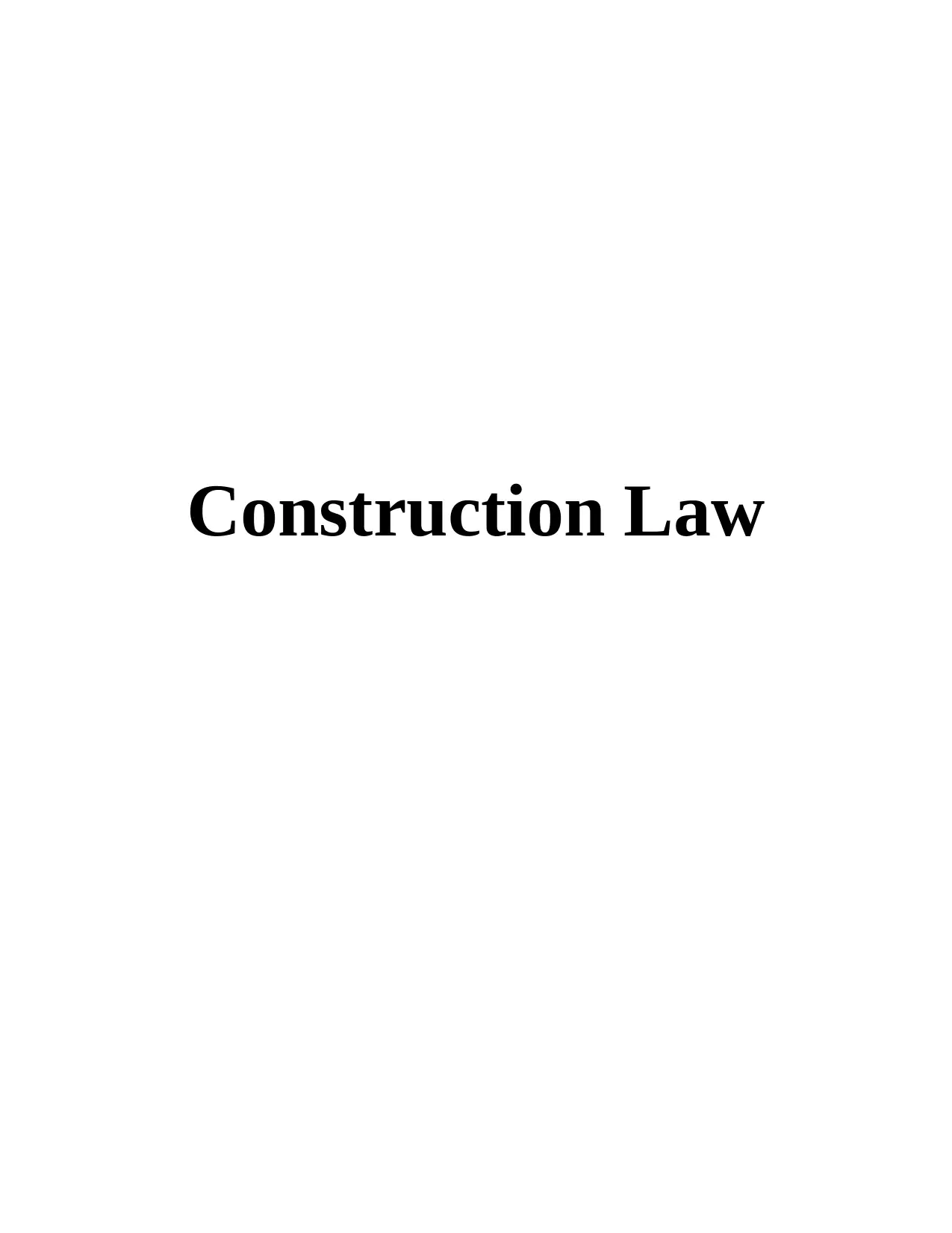
Construction Law
Paraphrase This Document
Need a fresh take? Get an instant paraphrase of this document with our AI Paraphraser
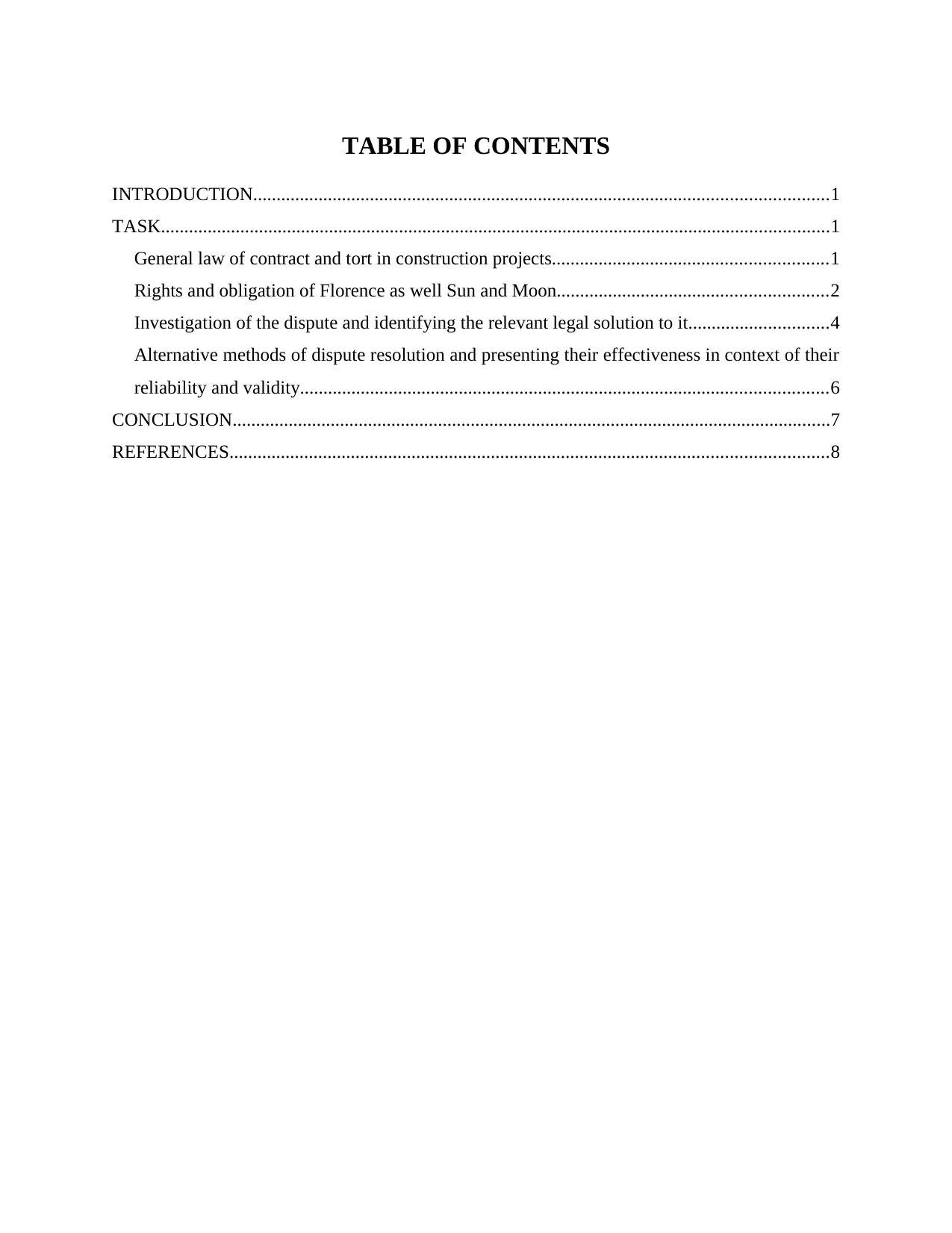
TABLE OF CONTENTS
INTRODUCTION...........................................................................................................................1
TASK...............................................................................................................................................1
General law of contract and tort in construction projects...........................................................1
Rights and obligation of Florence as well Sun and Moon..........................................................2
Investigation of the dispute and identifying the relevant legal solution to it..............................4
Alternative methods of dispute resolution and presenting their effectiveness in context of their
reliability and validity.................................................................................................................6
CONCLUSION................................................................................................................................7
REFERENCES................................................................................................................................8
INTRODUCTION...........................................................................................................................1
TASK...............................................................................................................................................1
General law of contract and tort in construction projects...........................................................1
Rights and obligation of Florence as well Sun and Moon..........................................................2
Investigation of the dispute and identifying the relevant legal solution to it..............................4
Alternative methods of dispute resolution and presenting their effectiveness in context of their
reliability and validity.................................................................................................................6
CONCLUSION................................................................................................................................7
REFERENCES................................................................................................................................8
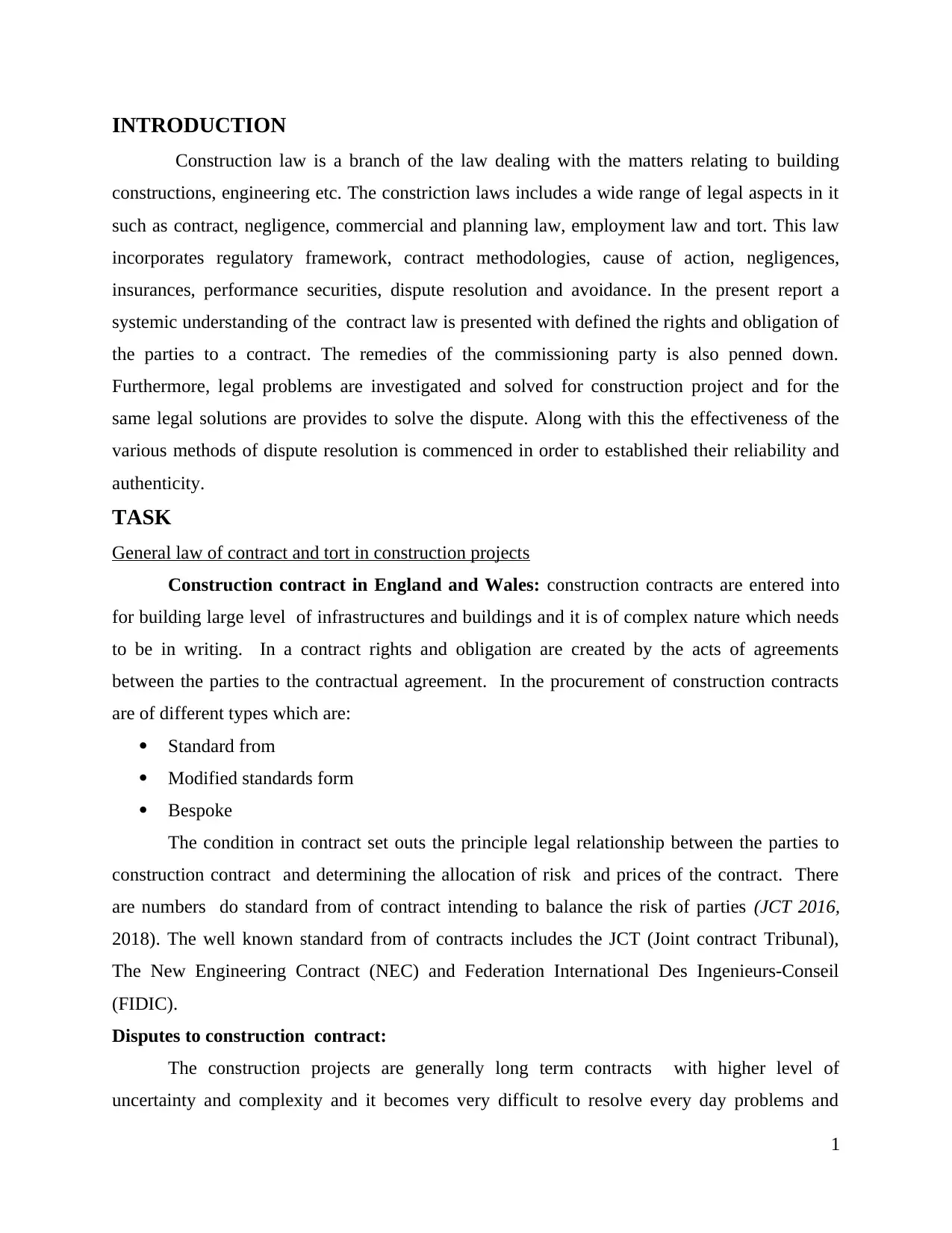
INTRODUCTION
Construction law is a branch of the law dealing with the matters relating to building
constructions, engineering etc. The constriction laws includes a wide range of legal aspects in it
such as contract, negligence, commercial and planning law, employment law and tort. This law
incorporates regulatory framework, contract methodologies, cause of action, negligences,
insurances, performance securities, dispute resolution and avoidance. In the present report a
systemic understanding of the contract law is presented with defined the rights and obligation of
the parties to a contract. The remedies of the commissioning party is also penned down.
Furthermore, legal problems are investigated and solved for construction project and for the
same legal solutions are provides to solve the dispute. Along with this the effectiveness of the
various methods of dispute resolution is commenced in order to established their reliability and
authenticity.
TASK
General law of contract and tort in construction projects
Construction contract in England and Wales: construction contracts are entered into
for building large level of infrastructures and buildings and it is of complex nature which needs
to be in writing. In a contract rights and obligation are created by the acts of agreements
between the parties to the contractual agreement. In the procurement of construction contracts
are of different types which are:
Standard from
Modified standards form
Bespoke
The condition in contract set outs the principle legal relationship between the parties to
construction contract and determining the allocation of risk and prices of the contract. There
are numbers do standard from of contract intending to balance the risk of parties (JCT 2016,
2018). The well known standard from of contracts includes the JCT (Joint contract Tribunal),
The New Engineering Contract (NEC) and Federation International Des Ingenieurs-Conseil
(FIDIC).
Disputes to construction contract:
The construction projects are generally long term contracts with higher level of
uncertainty and complexity and it becomes very difficult to resolve every day problems and
1
Construction law is a branch of the law dealing with the matters relating to building
constructions, engineering etc. The constriction laws includes a wide range of legal aspects in it
such as contract, negligence, commercial and planning law, employment law and tort. This law
incorporates regulatory framework, contract methodologies, cause of action, negligences,
insurances, performance securities, dispute resolution and avoidance. In the present report a
systemic understanding of the contract law is presented with defined the rights and obligation of
the parties to a contract. The remedies of the commissioning party is also penned down.
Furthermore, legal problems are investigated and solved for construction project and for the
same legal solutions are provides to solve the dispute. Along with this the effectiveness of the
various methods of dispute resolution is commenced in order to established their reliability and
authenticity.
TASK
General law of contract and tort in construction projects
Construction contract in England and Wales: construction contracts are entered into
for building large level of infrastructures and buildings and it is of complex nature which needs
to be in writing. In a contract rights and obligation are created by the acts of agreements
between the parties to the contractual agreement. In the procurement of construction contracts
are of different types which are:
Standard from
Modified standards form
Bespoke
The condition in contract set outs the principle legal relationship between the parties to
construction contract and determining the allocation of risk and prices of the contract. There
are numbers do standard from of contract intending to balance the risk of parties (JCT 2016,
2018). The well known standard from of contracts includes the JCT (Joint contract Tribunal),
The New Engineering Contract (NEC) and Federation International Des Ingenieurs-Conseil
(FIDIC).
Disputes to construction contract:
The construction projects are generally long term contracts with higher level of
uncertainty and complexity and it becomes very difficult to resolve every day problems and
1
⊘ This is a preview!⊘
Do you want full access?
Subscribe today to unlock all pages.

Trusted by 1+ million students worldwide
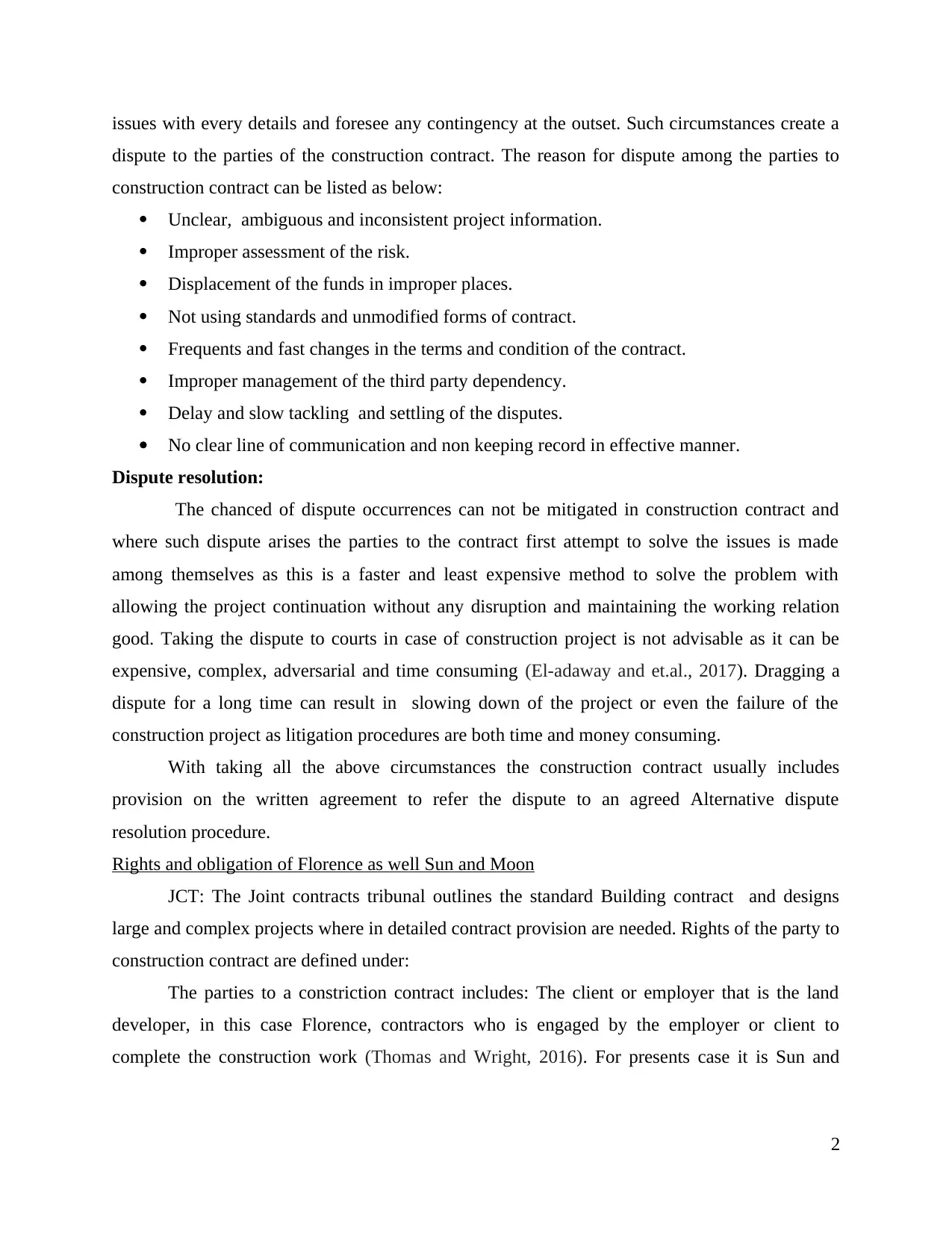
issues with every details and foresee any contingency at the outset. Such circumstances create a
dispute to the parties of the construction contract. The reason for dispute among the parties to
construction contract can be listed as below:
Unclear, ambiguous and inconsistent project information.
Improper assessment of the risk.
Displacement of the funds in improper places.
Not using standards and unmodified forms of contract.
Frequents and fast changes in the terms and condition of the contract.
Improper management of the third party dependency.
Delay and slow tackling and settling of the disputes.
No clear line of communication and non keeping record in effective manner.
Dispute resolution:
The chanced of dispute occurrences can not be mitigated in construction contract and
where such dispute arises the parties to the contract first attempt to solve the issues is made
among themselves as this is a faster and least expensive method to solve the problem with
allowing the project continuation without any disruption and maintaining the working relation
good. Taking the dispute to courts in case of construction project is not advisable as it can be
expensive, complex, adversarial and time consuming (El-adaway and et.al., 2017). Dragging a
dispute for a long time can result in slowing down of the project or even the failure of the
construction project as litigation procedures are both time and money consuming.
With taking all the above circumstances the construction contract usually includes
provision on the written agreement to refer the dispute to an agreed Alternative dispute
resolution procedure.
Rights and obligation of Florence as well Sun and Moon
JCT: The Joint contracts tribunal outlines the standard Building contract and designs
large and complex projects where in detailed contract provision are needed. Rights of the party to
construction contract are defined under:
The parties to a constriction contract includes: The client or employer that is the land
developer, in this case Florence, contractors who is engaged by the employer or client to
complete the construction work (Thomas and Wright, 2016). For presents case it is Sun and
2
dispute to the parties of the construction contract. The reason for dispute among the parties to
construction contract can be listed as below:
Unclear, ambiguous and inconsistent project information.
Improper assessment of the risk.
Displacement of the funds in improper places.
Not using standards and unmodified forms of contract.
Frequents and fast changes in the terms and condition of the contract.
Improper management of the third party dependency.
Delay and slow tackling and settling of the disputes.
No clear line of communication and non keeping record in effective manner.
Dispute resolution:
The chanced of dispute occurrences can not be mitigated in construction contract and
where such dispute arises the parties to the contract first attempt to solve the issues is made
among themselves as this is a faster and least expensive method to solve the problem with
allowing the project continuation without any disruption and maintaining the working relation
good. Taking the dispute to courts in case of construction project is not advisable as it can be
expensive, complex, adversarial and time consuming (El-adaway and et.al., 2017). Dragging a
dispute for a long time can result in slowing down of the project or even the failure of the
construction project as litigation procedures are both time and money consuming.
With taking all the above circumstances the construction contract usually includes
provision on the written agreement to refer the dispute to an agreed Alternative dispute
resolution procedure.
Rights and obligation of Florence as well Sun and Moon
JCT: The Joint contracts tribunal outlines the standard Building contract and designs
large and complex projects where in detailed contract provision are needed. Rights of the party to
construction contract are defined under:
The parties to a constriction contract includes: The client or employer that is the land
developer, in this case Florence, contractors who is engaged by the employer or client to
complete the construction work (Thomas and Wright, 2016). For presents case it is Sun and
2
Paraphrase This Document
Need a fresh take? Get an instant paraphrase of this document with our AI Paraphraser
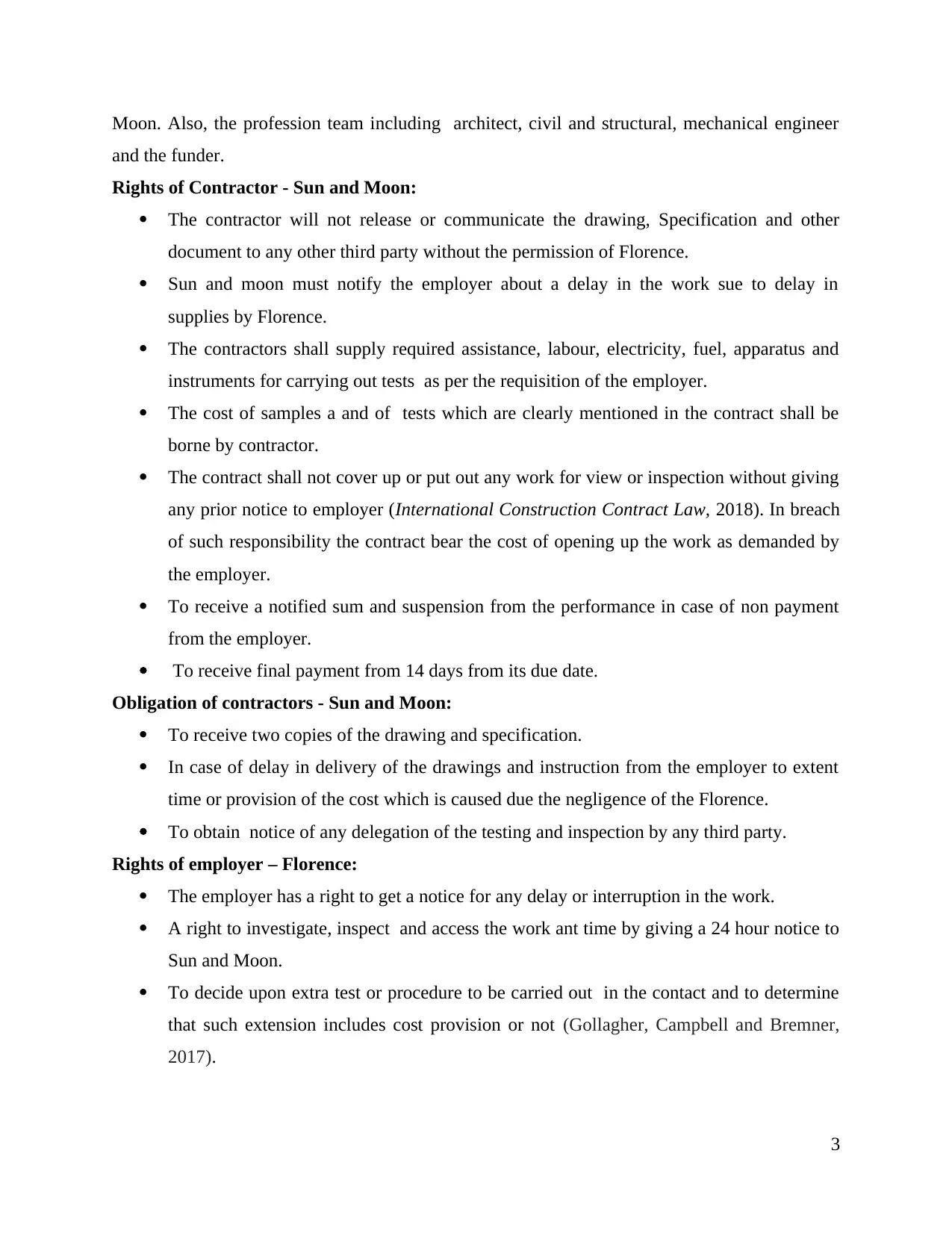
Moon. Also, the profession team including architect, civil and structural, mechanical engineer
and the funder.
Rights of Contractor - Sun and Moon:
The contractor will not release or communicate the drawing, Specification and other
document to any other third party without the permission of Florence.
Sun and moon must notify the employer about a delay in the work sue to delay in
supplies by Florence.
The contractors shall supply required assistance, labour, electricity, fuel, apparatus and
instruments for carrying out tests as per the requisition of the employer.
The cost of samples a and of tests which are clearly mentioned in the contract shall be
borne by contractor.
The contract shall not cover up or put out any work for view or inspection without giving
any prior notice to employer (International Construction Contract Law, 2018). In breach
of such responsibility the contract bear the cost of opening up the work as demanded by
the employer.
To receive a notified sum and suspension from the performance in case of non payment
from the employer.
To receive final payment from 14 days from its due date.
Obligation of contractors - Sun and Moon:
To receive two copies of the drawing and specification.
In case of delay in delivery of the drawings and instruction from the employer to extent
time or provision of the cost which is caused due the negligence of the Florence.
To obtain notice of any delegation of the testing and inspection by any third party.
Rights of employer – Florence:
The employer has a right to get a notice for any delay or interruption in the work.
A right to investigate, inspect and access the work ant time by giving a 24 hour notice to
Sun and Moon.
To decide upon extra test or procedure to be carried out in the contact and to determine
that such extension includes cost provision or not (Gollagher, Campbell and Bremner,
2017).
3
and the funder.
Rights of Contractor - Sun and Moon:
The contractor will not release or communicate the drawing, Specification and other
document to any other third party without the permission of Florence.
Sun and moon must notify the employer about a delay in the work sue to delay in
supplies by Florence.
The contractors shall supply required assistance, labour, electricity, fuel, apparatus and
instruments for carrying out tests as per the requisition of the employer.
The cost of samples a and of tests which are clearly mentioned in the contract shall be
borne by contractor.
The contract shall not cover up or put out any work for view or inspection without giving
any prior notice to employer (International Construction Contract Law, 2018). In breach
of such responsibility the contract bear the cost of opening up the work as demanded by
the employer.
To receive a notified sum and suspension from the performance in case of non payment
from the employer.
To receive final payment from 14 days from its due date.
Obligation of contractors - Sun and Moon:
To receive two copies of the drawing and specification.
In case of delay in delivery of the drawings and instruction from the employer to extent
time or provision of the cost which is caused due the negligence of the Florence.
To obtain notice of any delegation of the testing and inspection by any third party.
Rights of employer – Florence:
The employer has a right to get a notice for any delay or interruption in the work.
A right to investigate, inspect and access the work ant time by giving a 24 hour notice to
Sun and Moon.
To decide upon extra test or procedure to be carried out in the contact and to determine
that such extension includes cost provision or not (Gollagher, Campbell and Bremner,
2017).
3
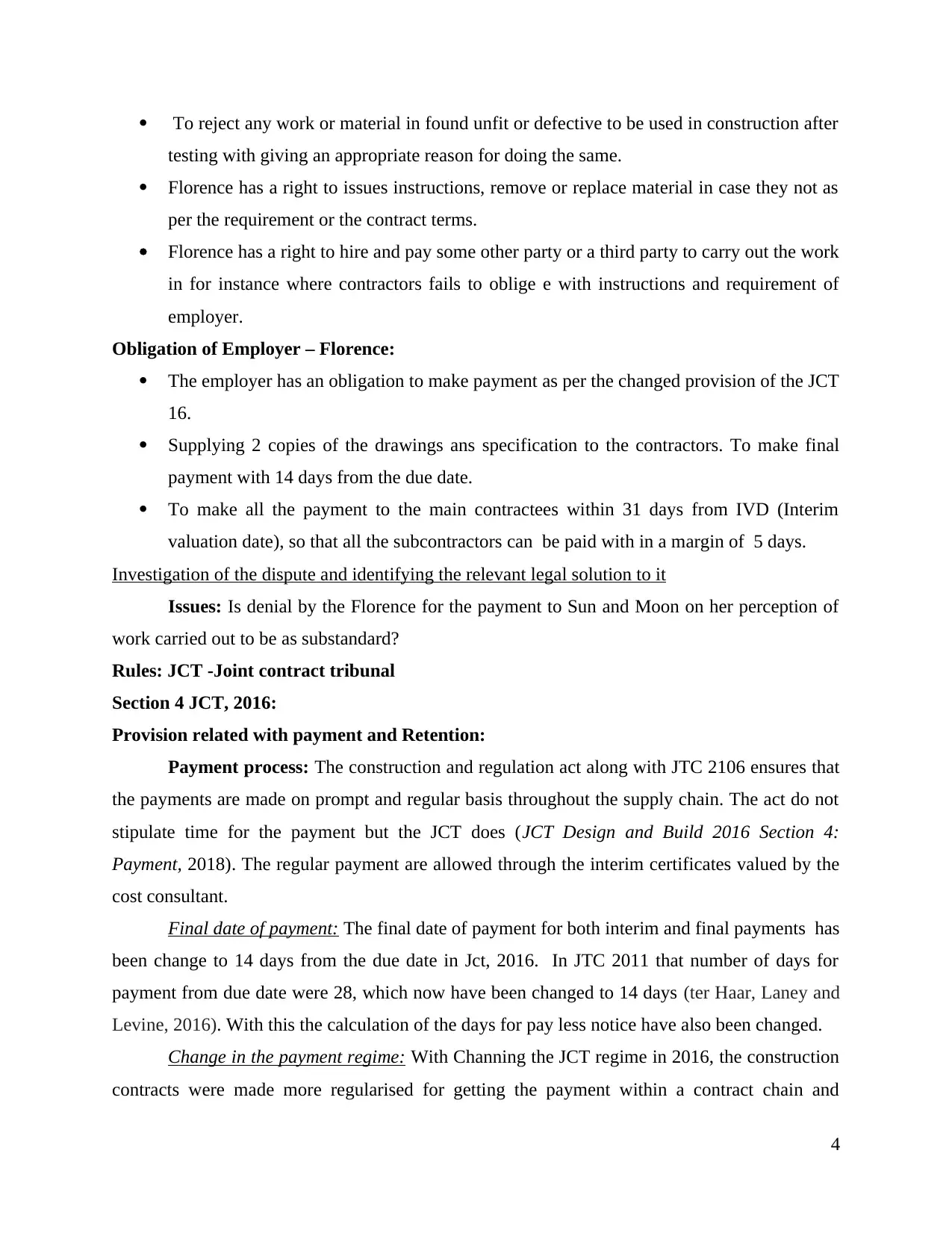
To reject any work or material in found unfit or defective to be used in construction after
testing with giving an appropriate reason for doing the same.
Florence has a right to issues instructions, remove or replace material in case they not as
per the requirement or the contract terms.
Florence has a right to hire and pay some other party or a third party to carry out the work
in for instance where contractors fails to oblige e with instructions and requirement of
employer.
Obligation of Employer – Florence:
The employer has an obligation to make payment as per the changed provision of the JCT
16.
Supplying 2 copies of the drawings ans specification to the contractors. To make final
payment with 14 days from the due date.
To make all the payment to the main contractees within 31 days from IVD (Interim
valuation date), so that all the subcontractors can be paid with in a margin of 5 days.
Investigation of the dispute and identifying the relevant legal solution to it
Issues: Is denial by the Florence for the payment to Sun and Moon on her perception of
work carried out to be as substandard?
Rules: JCT -Joint contract tribunal
Section 4 JCT, 2016:
Provision related with payment and Retention:
Payment process: The construction and regulation act along with JTC 2106 ensures that
the payments are made on prompt and regular basis throughout the supply chain. The act do not
stipulate time for the payment but the JCT does (JCT Design and Build 2016 Section 4:
Payment, 2018). The regular payment are allowed through the interim certificates valued by the
cost consultant.
Final date of payment: The final date of payment for both interim and final payments has
been change to 14 days from the due date in Jct, 2016. In JTC 2011 that number of days for
payment from due date were 28, which now have been changed to 14 days (ter Haar, Laney and
Levine, 2016). With this the calculation of the days for pay less notice have also been changed.
Change in the payment regime: With Channing the JCT regime in 2016, the construction
contracts were made more regularised for getting the payment within a contract chain and
4
testing with giving an appropriate reason for doing the same.
Florence has a right to issues instructions, remove or replace material in case they not as
per the requirement or the contract terms.
Florence has a right to hire and pay some other party or a third party to carry out the work
in for instance where contractors fails to oblige e with instructions and requirement of
employer.
Obligation of Employer – Florence:
The employer has an obligation to make payment as per the changed provision of the JCT
16.
Supplying 2 copies of the drawings ans specification to the contractors. To make final
payment with 14 days from the due date.
To make all the payment to the main contractees within 31 days from IVD (Interim
valuation date), so that all the subcontractors can be paid with in a margin of 5 days.
Investigation of the dispute and identifying the relevant legal solution to it
Issues: Is denial by the Florence for the payment to Sun and Moon on her perception of
work carried out to be as substandard?
Rules: JCT -Joint contract tribunal
Section 4 JCT, 2016:
Provision related with payment and Retention:
Payment process: The construction and regulation act along with JTC 2106 ensures that
the payments are made on prompt and regular basis throughout the supply chain. The act do not
stipulate time for the payment but the JCT does (JCT Design and Build 2016 Section 4:
Payment, 2018). The regular payment are allowed through the interim certificates valued by the
cost consultant.
Final date of payment: The final date of payment for both interim and final payments has
been change to 14 days from the due date in Jct, 2016. In JTC 2011 that number of days for
payment from due date were 28, which now have been changed to 14 days (ter Haar, Laney and
Levine, 2016). With this the calculation of the days for pay less notice have also been changed.
Change in the payment regime: With Channing the JCT regime in 2016, the construction
contracts were made more regularised for getting the payment within a contract chain and
4
⊘ This is a preview!⊘
Do you want full access?
Subscribe today to unlock all pages.

Trusted by 1+ million students worldwide
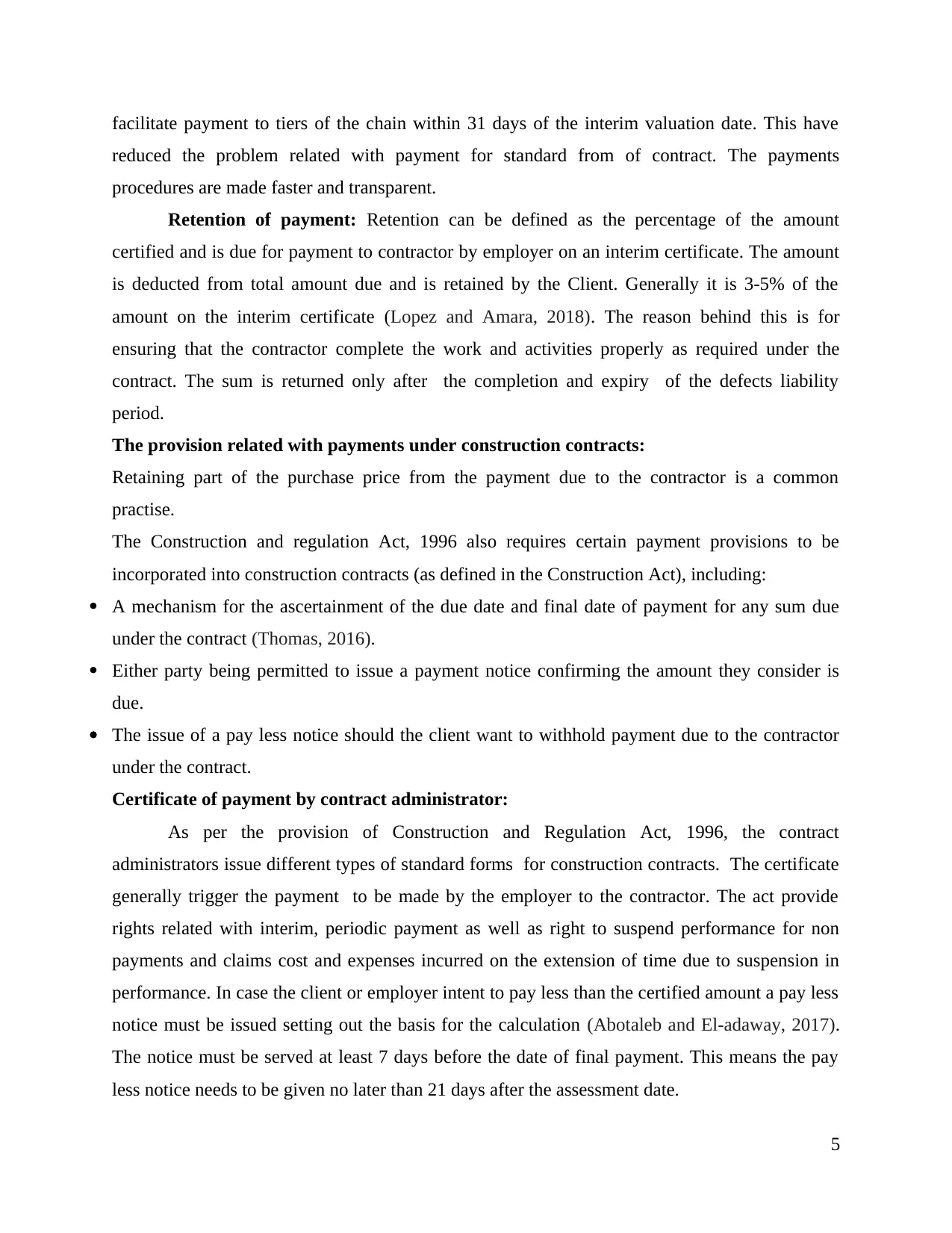
facilitate payment to tiers of the chain within 31 days of the interim valuation date. This have
reduced the problem related with payment for standard from of contract. The payments
procedures are made faster and transparent.
Retention of payment: Retention can be defined as the percentage of the amount
certified and is due for payment to contractor by employer on an interim certificate. The amount
is deducted from total amount due and is retained by the Client. Generally it is 3-5% of the
amount on the interim certificate (Lopez and Amara, 2018). The reason behind this is for
ensuring that the contractor complete the work and activities properly as required under the
contract. The sum is returned only after the completion and expiry of the defects liability
period.
The provision related with payments under construction contracts:
Retaining part of the purchase price from the payment due to the contractor is a common
practise.
The Construction and regulation Act, 1996 also requires certain payment provisions to be
incorporated into construction contracts (as defined in the Construction Act), including:
A mechanism for the ascertainment of the due date and final date of payment for any sum due
under the contract (Thomas, 2016).
Either party being permitted to issue a payment notice confirming the amount they consider is
due.
The issue of a pay less notice should the client want to withhold payment due to the contractor
under the contract.
Certificate of payment by contract administrator:
As per the provision of Construction and Regulation Act, 1996, the contract
administrators issue different types of standard forms for construction contracts. The certificate
generally trigger the payment to be made by the employer to the contractor. The act provide
rights related with interim, periodic payment as well as right to suspend performance for non
payments and claims cost and expenses incurred on the extension of time due to suspension in
performance. In case the client or employer intent to pay less than the certified amount a pay less
notice must be issued setting out the basis for the calculation (Abotaleb and El-adaway, 2017).
The notice must be served at least 7 days before the date of final payment. This means the pay
less notice needs to be given no later than 21 days after the assessment date.
5
reduced the problem related with payment for standard from of contract. The payments
procedures are made faster and transparent.
Retention of payment: Retention can be defined as the percentage of the amount
certified and is due for payment to contractor by employer on an interim certificate. The amount
is deducted from total amount due and is retained by the Client. Generally it is 3-5% of the
amount on the interim certificate (Lopez and Amara, 2018). The reason behind this is for
ensuring that the contractor complete the work and activities properly as required under the
contract. The sum is returned only after the completion and expiry of the defects liability
period.
The provision related with payments under construction contracts:
Retaining part of the purchase price from the payment due to the contractor is a common
practise.
The Construction and regulation Act, 1996 also requires certain payment provisions to be
incorporated into construction contracts (as defined in the Construction Act), including:
A mechanism for the ascertainment of the due date and final date of payment for any sum due
under the contract (Thomas, 2016).
Either party being permitted to issue a payment notice confirming the amount they consider is
due.
The issue of a pay less notice should the client want to withhold payment due to the contractor
under the contract.
Certificate of payment by contract administrator:
As per the provision of Construction and Regulation Act, 1996, the contract
administrators issue different types of standard forms for construction contracts. The certificate
generally trigger the payment to be made by the employer to the contractor. The act provide
rights related with interim, periodic payment as well as right to suspend performance for non
payments and claims cost and expenses incurred on the extension of time due to suspension in
performance. In case the client or employer intent to pay less than the certified amount a pay less
notice must be issued setting out the basis for the calculation (Abotaleb and El-adaway, 2017).
The notice must be served at least 7 days before the date of final payment. This means the pay
less notice needs to be given no later than 21 days after the assessment date.
5
Paraphrase This Document
Need a fresh take? Get an instant paraphrase of this document with our AI Paraphraser
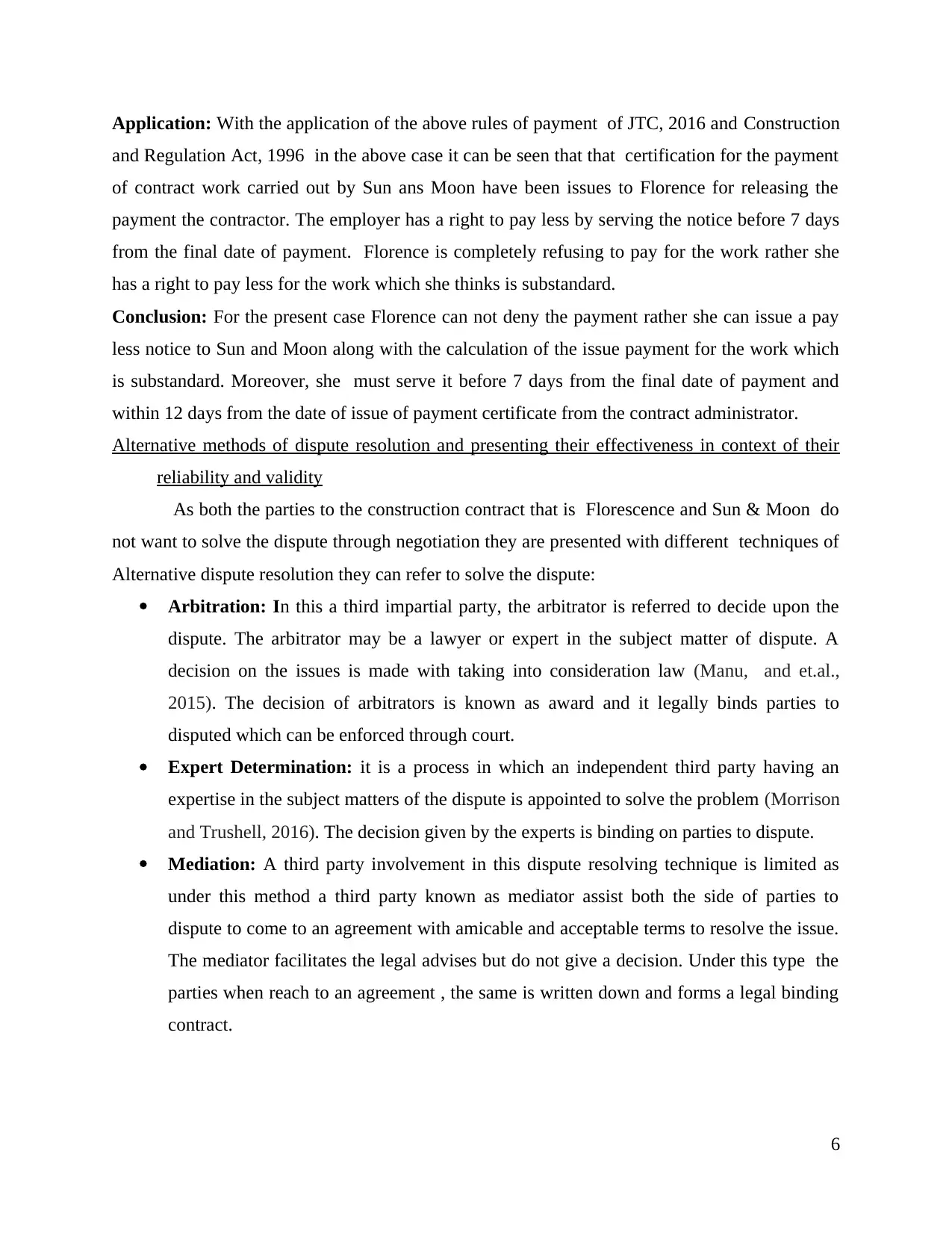
Application: With the application of the above rules of payment of JTC, 2016 and Construction
and Regulation Act, 1996 in the above case it can be seen that that certification for the payment
of contract work carried out by Sun ans Moon have been issues to Florence for releasing the
payment the contractor. The employer has a right to pay less by serving the notice before 7 days
from the final date of payment. Florence is completely refusing to pay for the work rather she
has a right to pay less for the work which she thinks is substandard.
Conclusion: For the present case Florence can not deny the payment rather she can issue a pay
less notice to Sun and Moon along with the calculation of the issue payment for the work which
is substandard. Moreover, she must serve it before 7 days from the final date of payment and
within 12 days from the date of issue of payment certificate from the contract administrator.
Alternative methods of dispute resolution and presenting their effectiveness in context of their
reliability and validity
As both the parties to the construction contract that is Florescence and Sun & Moon do
not want to solve the dispute through negotiation they are presented with different techniques of
Alternative dispute resolution they can refer to solve the dispute:
Arbitration: In this a third impartial party, the arbitrator is referred to decide upon the
dispute. The arbitrator may be a lawyer or expert in the subject matter of dispute. A
decision on the issues is made with taking into consideration law (Manu, and et.al.,
2015). The decision of arbitrators is known as award and it legally binds parties to
disputed which can be enforced through court.
Expert Determination: it is a process in which an independent third party having an
expertise in the subject matters of the dispute is appointed to solve the problem (Morrison
and Trushell, 2016). The decision given by the experts is binding on parties to dispute.
Mediation: A third party involvement in this dispute resolving technique is limited as
under this method a third party known as mediator assist both the side of parties to
dispute to come to an agreement with amicable and acceptable terms to resolve the issue.
The mediator facilitates the legal advises but do not give a decision. Under this type the
parties when reach to an agreement , the same is written down and forms a legal binding
contract.
6
and Regulation Act, 1996 in the above case it can be seen that that certification for the payment
of contract work carried out by Sun ans Moon have been issues to Florence for releasing the
payment the contractor. The employer has a right to pay less by serving the notice before 7 days
from the final date of payment. Florence is completely refusing to pay for the work rather she
has a right to pay less for the work which she thinks is substandard.
Conclusion: For the present case Florence can not deny the payment rather she can issue a pay
less notice to Sun and Moon along with the calculation of the issue payment for the work which
is substandard. Moreover, she must serve it before 7 days from the final date of payment and
within 12 days from the date of issue of payment certificate from the contract administrator.
Alternative methods of dispute resolution and presenting their effectiveness in context of their
reliability and validity
As both the parties to the construction contract that is Florescence and Sun & Moon do
not want to solve the dispute through negotiation they are presented with different techniques of
Alternative dispute resolution they can refer to solve the dispute:
Arbitration: In this a third impartial party, the arbitrator is referred to decide upon the
dispute. The arbitrator may be a lawyer or expert in the subject matter of dispute. A
decision on the issues is made with taking into consideration law (Manu, and et.al.,
2015). The decision of arbitrators is known as award and it legally binds parties to
disputed which can be enforced through court.
Expert Determination: it is a process in which an independent third party having an
expertise in the subject matters of the dispute is appointed to solve the problem (Morrison
and Trushell, 2016). The decision given by the experts is binding on parties to dispute.
Mediation: A third party involvement in this dispute resolving technique is limited as
under this method a third party known as mediator assist both the side of parties to
dispute to come to an agreement with amicable and acceptable terms to resolve the issue.
The mediator facilitates the legal advises but do not give a decision. Under this type the
parties when reach to an agreement , the same is written down and forms a legal binding
contract.
6
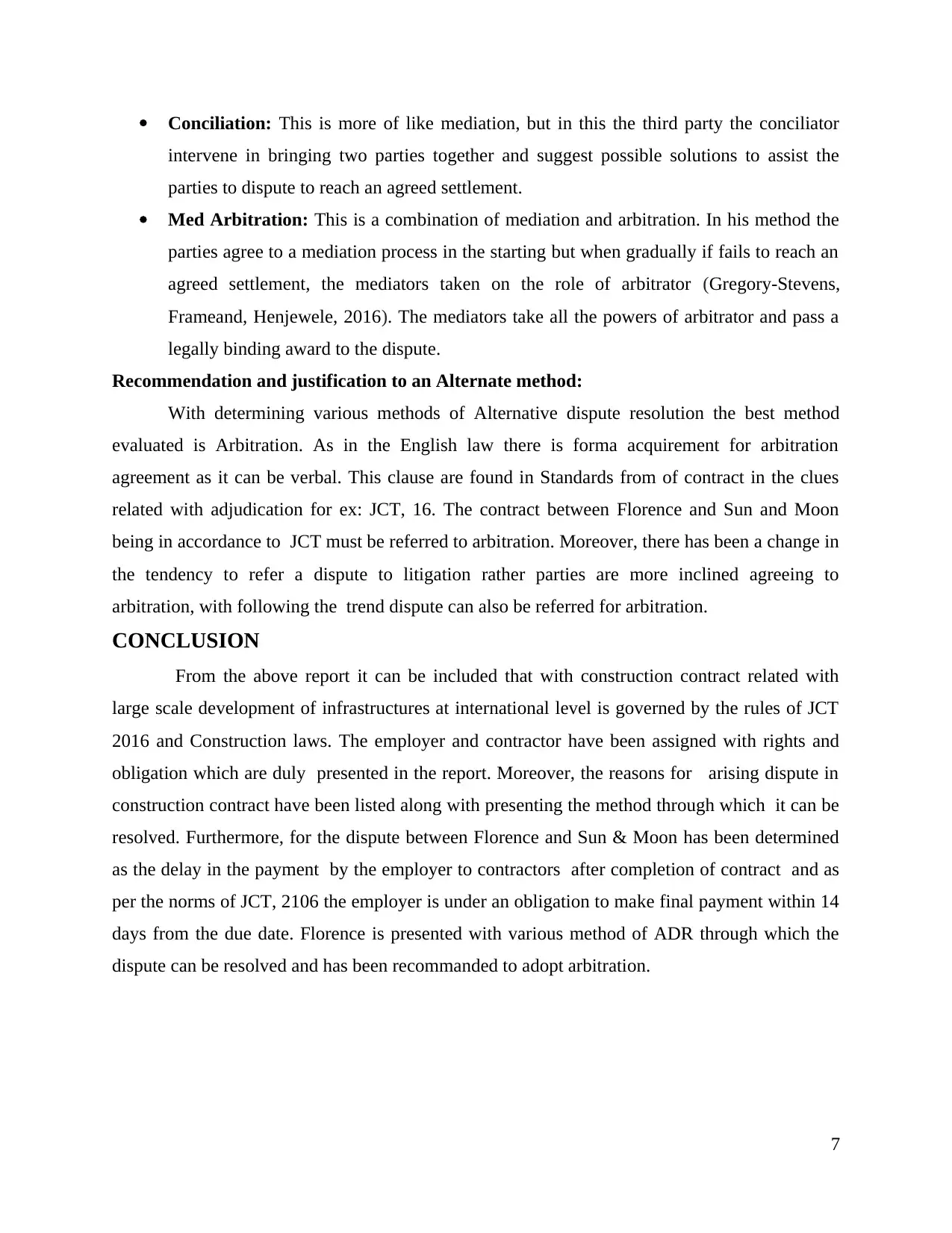
Conciliation: This is more of like mediation, but in this the third party the conciliator
intervene in bringing two parties together and suggest possible solutions to assist the
parties to dispute to reach an agreed settlement.
Med Arbitration: This is a combination of mediation and arbitration. In his method the
parties agree to a mediation process in the starting but when gradually if fails to reach an
agreed settlement, the mediators taken on the role of arbitrator (Gregory-Stevens,
Frameand, Henjewele, 2016). The mediators take all the powers of arbitrator and pass a
legally binding award to the dispute.
Recommendation and justification to an Alternate method:
With determining various methods of Alternative dispute resolution the best method
evaluated is Arbitration. As in the English law there is forma acquirement for arbitration
agreement as it can be verbal. This clause are found in Standards from of contract in the clues
related with adjudication for ex: JCT, 16. The contract between Florence and Sun and Moon
being in accordance to JCT must be referred to arbitration. Moreover, there has been a change in
the tendency to refer a dispute to litigation rather parties are more inclined agreeing to
arbitration, with following the trend dispute can also be referred for arbitration.
CONCLUSION
From the above report it can be included that with construction contract related with
large scale development of infrastructures at international level is governed by the rules of JCT
2016 and Construction laws. The employer and contractor have been assigned with rights and
obligation which are duly presented in the report. Moreover, the reasons for arising dispute in
construction contract have been listed along with presenting the method through which it can be
resolved. Furthermore, for the dispute between Florence and Sun & Moon has been determined
as the delay in the payment by the employer to contractors after completion of contract and as
per the norms of JCT, 2106 the employer is under an obligation to make final payment within 14
days from the due date. Florence is presented with various method of ADR through which the
dispute can be resolved and has been recommanded to adopt arbitration.
7
intervene in bringing two parties together and suggest possible solutions to assist the
parties to dispute to reach an agreed settlement.
Med Arbitration: This is a combination of mediation and arbitration. In his method the
parties agree to a mediation process in the starting but when gradually if fails to reach an
agreed settlement, the mediators taken on the role of arbitrator (Gregory-Stevens,
Frameand, Henjewele, 2016). The mediators take all the powers of arbitrator and pass a
legally binding award to the dispute.
Recommendation and justification to an Alternate method:
With determining various methods of Alternative dispute resolution the best method
evaluated is Arbitration. As in the English law there is forma acquirement for arbitration
agreement as it can be verbal. This clause are found in Standards from of contract in the clues
related with adjudication for ex: JCT, 16. The contract between Florence and Sun and Moon
being in accordance to JCT must be referred to arbitration. Moreover, there has been a change in
the tendency to refer a dispute to litigation rather parties are more inclined agreeing to
arbitration, with following the trend dispute can also be referred for arbitration.
CONCLUSION
From the above report it can be included that with construction contract related with
large scale development of infrastructures at international level is governed by the rules of JCT
2016 and Construction laws. The employer and contractor have been assigned with rights and
obligation which are duly presented in the report. Moreover, the reasons for arising dispute in
construction contract have been listed along with presenting the method through which it can be
resolved. Furthermore, for the dispute between Florence and Sun & Moon has been determined
as the delay in the payment by the employer to contractors after completion of contract and as
per the norms of JCT, 2106 the employer is under an obligation to make final payment within 14
days from the due date. Florence is presented with various method of ADR through which the
dispute can be resolved and has been recommanded to adopt arbitration.
7
⊘ This is a preview!⊘
Do you want full access?
Subscribe today to unlock all pages.

Trusted by 1+ million students worldwide
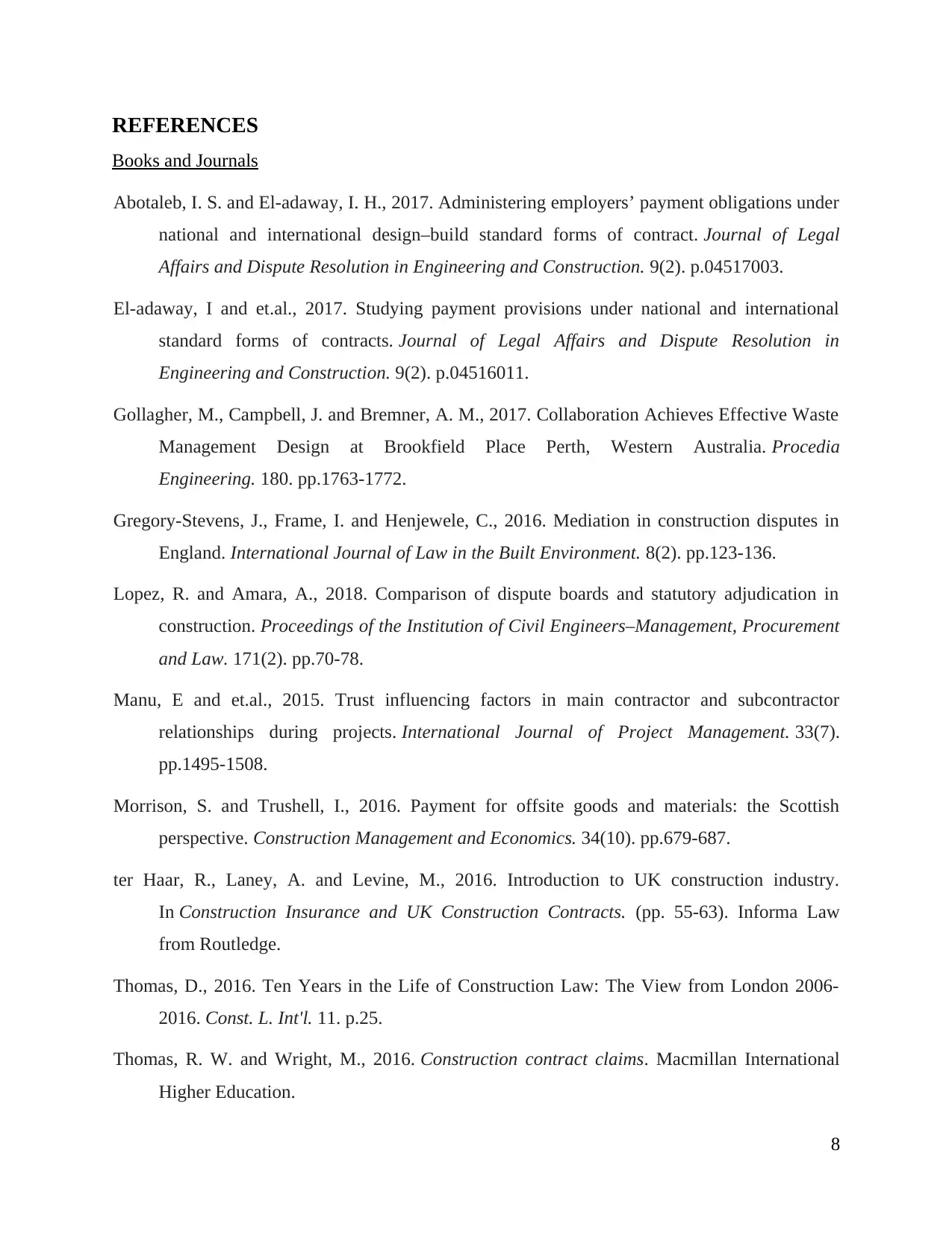
REFERENCES
Books and Journals
Abotaleb, I. S. and El-adaway, I. H., 2017. Administering employers’ payment obligations under
national and international design–build standard forms of contract. Journal of Legal
Affairs and Dispute Resolution in Engineering and Construction. 9(2). p.04517003.
El-adaway, I and et.al., 2017. Studying payment provisions under national and international
standard forms of contracts. Journal of Legal Affairs and Dispute Resolution in
Engineering and Construction. 9(2). p.04516011.
Gollagher, M., Campbell, J. and Bremner, A. M., 2017. Collaboration Achieves Effective Waste
Management Design at Brookfield Place Perth, Western Australia. Procedia
Engineering. 180. pp.1763-1772.
Gregory-Stevens, J., Frame, I. and Henjewele, C., 2016. Mediation in construction disputes in
England. International Journal of Law in the Built Environment. 8(2). pp.123-136.
Lopez, R. and Amara, A., 2018. Comparison of dispute boards and statutory adjudication in
construction. Proceedings of the Institution of Civil Engineers–Management, Procurement
and Law. 171(2). pp.70-78.
Manu, E and et.al., 2015. Trust influencing factors in main contractor and subcontractor
relationships during projects. International Journal of Project Management. 33(7).
pp.1495-1508.
Morrison, S. and Trushell, I., 2016. Payment for offsite goods and materials: the Scottish
perspective. Construction Management and Economics. 34(10). pp.679-687.
ter Haar, R., Laney, A. and Levine, M., 2016. Introduction to UK construction industry.
In Construction Insurance and UK Construction Contracts. (pp. 55-63). Informa Law
from Routledge.
Thomas, D., 2016. Ten Years in the Life of Construction Law: The View from London 2006-
2016. Const. L. Int'l. 11. p.25.
Thomas, R. W. and Wright, M., 2016. Construction contract claims. Macmillan International
Higher Education.
8
Books and Journals
Abotaleb, I. S. and El-adaway, I. H., 2017. Administering employers’ payment obligations under
national and international design–build standard forms of contract. Journal of Legal
Affairs and Dispute Resolution in Engineering and Construction. 9(2). p.04517003.
El-adaway, I and et.al., 2017. Studying payment provisions under national and international
standard forms of contracts. Journal of Legal Affairs and Dispute Resolution in
Engineering and Construction. 9(2). p.04516011.
Gollagher, M., Campbell, J. and Bremner, A. M., 2017. Collaboration Achieves Effective Waste
Management Design at Brookfield Place Perth, Western Australia. Procedia
Engineering. 180. pp.1763-1772.
Gregory-Stevens, J., Frame, I. and Henjewele, C., 2016. Mediation in construction disputes in
England. International Journal of Law in the Built Environment. 8(2). pp.123-136.
Lopez, R. and Amara, A., 2018. Comparison of dispute boards and statutory adjudication in
construction. Proceedings of the Institution of Civil Engineers–Management, Procurement
and Law. 171(2). pp.70-78.
Manu, E and et.al., 2015. Trust influencing factors in main contractor and subcontractor
relationships during projects. International Journal of Project Management. 33(7).
pp.1495-1508.
Morrison, S. and Trushell, I., 2016. Payment for offsite goods and materials: the Scottish
perspective. Construction Management and Economics. 34(10). pp.679-687.
ter Haar, R., Laney, A. and Levine, M., 2016. Introduction to UK construction industry.
In Construction Insurance and UK Construction Contracts. (pp. 55-63). Informa Law
from Routledge.
Thomas, D., 2016. Ten Years in the Life of Construction Law: The View from London 2006-
2016. Const. L. Int'l. 11. p.25.
Thomas, R. W. and Wright, M., 2016. Construction contract claims. Macmillan International
Higher Education.
8
Paraphrase This Document
Need a fresh take? Get an instant paraphrase of this document with our AI Paraphraser
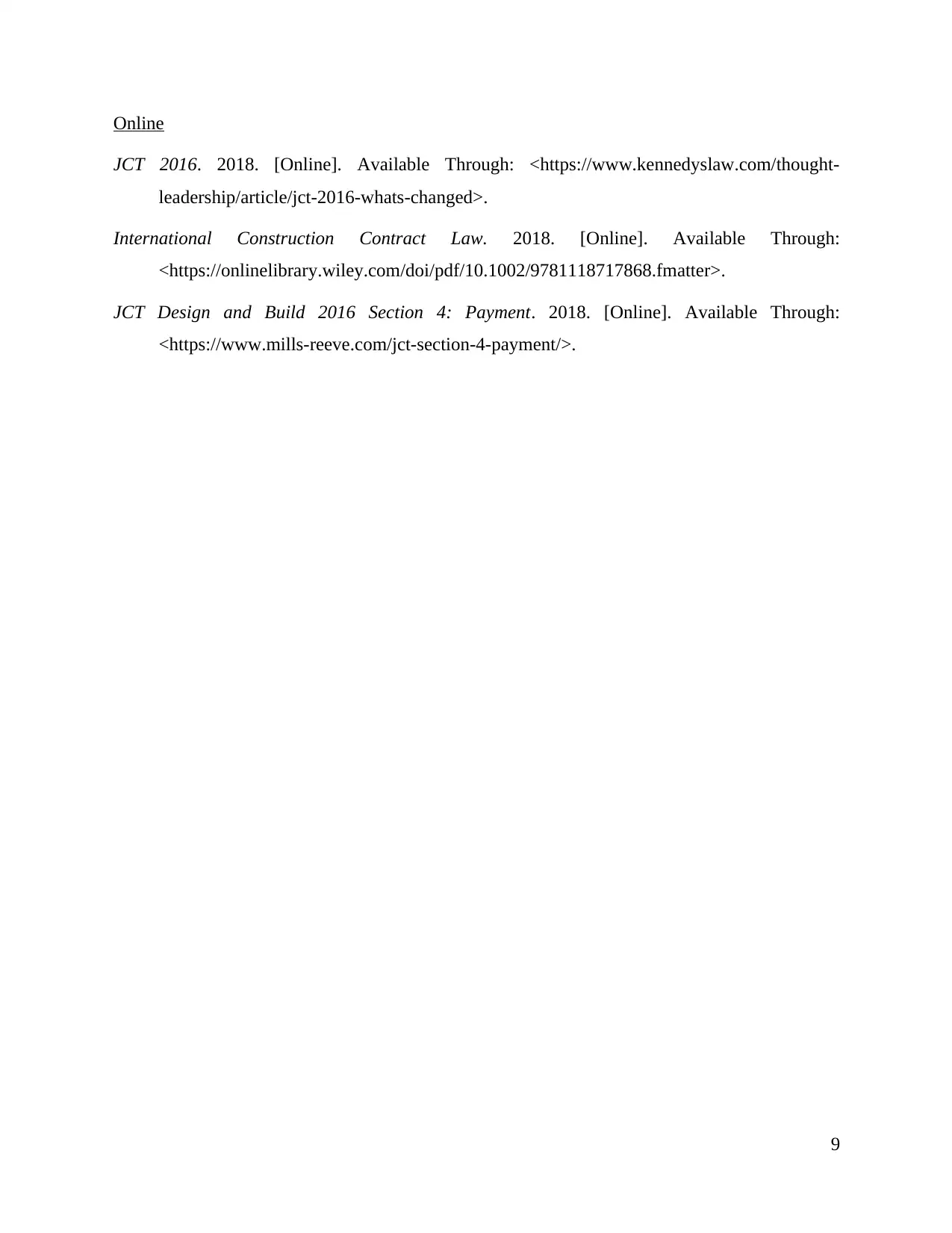
Online
JCT 2016. 2018. [Online]. Available Through: <https://www.kennedyslaw.com/thought-
leadership/article/jct-2016-whats-changed>.
International Construction Contract Law. 2018. [Online]. Available Through:
<https://onlinelibrary.wiley.com/doi/pdf/10.1002/9781118717868.fmatter>.
JCT Design and Build 2016 Section 4: Payment. 2018. [Online]. Available Through:
<https://www.mills-reeve.com/jct-section-4-payment/>.
9
JCT 2016. 2018. [Online]. Available Through: <https://www.kennedyslaw.com/thought-
leadership/article/jct-2016-whats-changed>.
International Construction Contract Law. 2018. [Online]. Available Through:
<https://onlinelibrary.wiley.com/doi/pdf/10.1002/9781118717868.fmatter>.
JCT Design and Build 2016 Section 4: Payment. 2018. [Online]. Available Through:
<https://www.mills-reeve.com/jct-section-4-payment/>.
9
1 out of 11
Related Documents
Your All-in-One AI-Powered Toolkit for Academic Success.
+13062052269
info@desklib.com
Available 24*7 on WhatsApp / Email
![[object Object]](/_next/static/media/star-bottom.7253800d.svg)
Unlock your academic potential
Copyright © 2020–2025 A2Z Services. All Rights Reserved. Developed and managed by ZUCOL.





